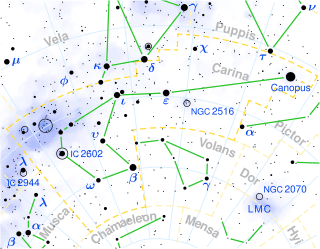V518 Carinae
V518 Carinae (HR 4196) is a naked-eye variable star in the constellation Carina. It is a member of the bright open cluster IC 2602 near the Carina Nebula.
 | |
| Observation data Epoch J2000.0 Equinox J2000.0 | |
|---|---|
| Constellation | Carina |
| Right ascension | 10h 42m 14.12040s[1] |
| Declination | −64° 27′ 59.1323″[1] |
| Apparent magnitude (V) | 4.82[2] |
| Characteristics | |
| Spectral type | B3/5V[3] |
| U−B color index | −0.58[2] |
| B−V color index | −0.14[2] |
| Variable type | γ Cas?[4] |
| Astrometry | |
| Parallax (π) | 7.19 ± 0.20[1] mas |
| Distance | 450 ± 10 ly (139 ± 4 pc) |
| Absolute magnitude (MV) | −1.169[5] |
| Details | |
| Mass | 6.2[6] M☉ |
| Radius | 3.30±0.07[7] R☉ |
| Luminosity | 753[5] L☉ |
| Surface gravity (log g) | 4.015[8] cgs |
| Temperature | 15,397[5] K |
| Rotational velocity (v sin i) | 120[8] km/s |
| Age | 17.2[9] Myr |
| Other designations | |
| Database references | |
| SIMBAD | data |
Location
V518 Carinae lies in the open cluster IC 2602, 5 arc minutes from its brightest member θ Carinae.
Variability
518 Carinae was discovered to change in brightness after analysis of Hipparcos photometry. The amplitude of the variations seen is 0.2 magnitudes, with possible periods of 100 and 971 days.[10] It is classified as a γ Cassiopeiae variable.[11][4]
Spectral peculiarities
V518 Carinae is classified as a B-type main sequence star between B3 and B5.[12] It is also catalogued as a helium star, a chemically peculiar star with abnormally strong helium absorption lines in its spectrum and relatively weak hydrogen lines. It is possibly a blue straggler.[13]
V518 Carinae is also a Be star, a hot star with emission lines in its spectrum due to a disk of material around the star. Be stars that show irregular brightness changes due to the disk are grouped as γ Cassiopeiae variables. V518 Carinae is known to produce disk outbursts lasting several hundred days.[14]
References
- Van Leeuwen, F (2007). "Validation of the new Hipparcos reduction". Astronomy and Astrophysics. 474 (2): 653. arXiv:0708.1752. Bibcode:2007A&A...474..653V. doi:10.1051/0004-6361:20078357.
- Ducati, J. R (2002). "VizieR Online Data Catalog: Catalogue of Stellar Photometry in Johnson's 11-color system". CDS/ADC Collection of Electronic Catalogues. 2237. Bibcode:2002yCat.2237....0D.
- Houk, N; Cowley, A. P (1975). "University of Michigan Catalogue of two-dimensional spectral types for the HD stars. Volume I. Declinations -90_ to -53_ƒ0". University of Michigan Catalogue of two-dimensional spectral types for the HD stars. Volume I. Declinations -90_ to -53_ƒ0. Bibcode:1975mcts.book.....H.
- Samus', N. N; Kazarovets, E. V; Durlevich, O. V; Kireeva, N. N; Pastukhova, E. N (2017). "General catalogue of variable stars: Version GCVS 5.1". Astronomy Reports. 61: 80. Bibcode:2017ARep...61...80S. doi:10.1134/S1063772917010085.
- Silaj, J; Landstreet, J. D (2014). "Accurate age determinations of several nearby open clusters containing magnetic Ap stars". Astronomy & Astrophysics. 566: A132. arXiv:1407.4531. Bibcode:2014A&A...566A.132S. doi:10.1051/0004-6361/201321468.
- Tetzlaff, N; Neuhäuser, R; Hohle, M. M (2011). "A catalogue of young runaway Hipparcos stars within 3 kpc from the Sun". Monthly Notices of the Royal Astronomical Society. 410: 190. arXiv:1007.4883. Bibcode:2011MNRAS.410..190T. doi:10.1111/j.1365-2966.2010.17434.x.
- Arcos, C.; et al. (March 2018). "Stellar parameters and H α line profile variability of Be stars in the BeSOS survey". Monthly Notices of the Royal Astronomical Society. 474 (4): 5287–5299. arXiv:1711.08675. Bibcode:2018MNRAS.474.5287A. doi:10.1093/mnras/stx3075.
- David, Trevor J; Hillenbrand, Lynne A (2015). "The Ages of Early-type Stars: Strömgren Photometric Methods Calibrated, Validated, Tested, and Applied to Hosts and Prospective Hosts of Directly Imaged Exoplanets". The Astrophysical Journal. 804 (2): 146. arXiv:1501.03154. Bibcode:2015ApJ...804..146D. doi:10.1088/0004-637X/804/2/146.
- Gullikson, Kevin; Dodson-Robinson, Sarah (2013). "Detection of Low-Mass-ratio Stellar Binary Systems". The Astronomical Journal. 145: 3. arXiv:1210.6360. Bibcode:2013AJ....145....3G. doi:10.1088/0004-6256/145/1/3.
- Lefèvre, L; Marchenko, S. V; Moffat, A. F. J; Acker, A (2009). "A systematic study of variability among OB-stars based on HIPPARCOS photometry". Astronomy and Astrophysics. 507 (2): 1141. Bibcode:2009A&A...507.1141L. doi:10.1051/0004-6361/200912304.
- Adelman, S. J; Mayer, M. R; Rosidivito, M. A (2000). "On the Variability of O4-B5 Luminosity Class III-V Stars". Information Bulletin on Variable Stars. 5008: 1. Bibcode:2000IBVS.5008....1A.
- Skiff, B. A (2014). "VizieR Online Data Catalog: Catalogue of Stellar Spectral Classifications (Skiff, 2009-2016)". VizieR On-line Data Catalog: B/mk. Originally Published in: Lowell Observatory (October 2014). 1. Bibcode:2014yCat....1.2023S.
- Renson, P; Manfroid, J (2009). "Catalogue of Ap, Hg Mn and Am stars" (PDF). Astronomy and Astrophysics. 498 (3): 961. Bibcode:2009A&A...498..961R. doi:10.1051/0004-6361/200810788.
- Mennickent, R. E; Sabogal, B; Granada, A; Cidale, L (2009). "L-Band Spectra of 13 Outbursting Be Stars". Publications of the Astronomical Society of the Pacific. 121 (876): 125. arXiv:0902.4279. Bibcode:2009PASP..121..125M. doi:10.1086/597551.